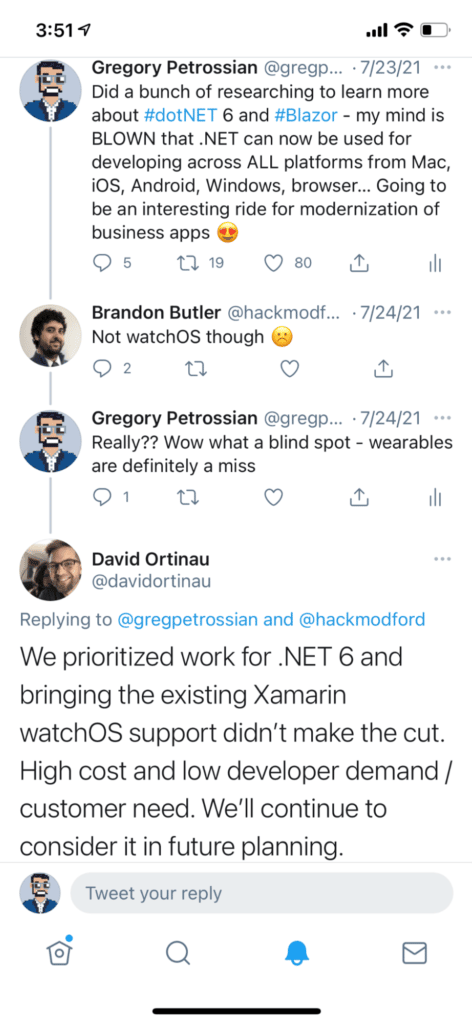Unless you’ve been living under a rock, we don’t have to tell you that:
- Everyone is living on their phones these days, and…
- Most people switch devices throughout the day. They go from Android to iOS, from desktop to mobile, from Windows to Mac, and…
- They all expect a seamless experience.
If you have to create separate codebases to deliver a consistent user experience across all platforms, you’d be paying through the nose. We don’t like that. That’s why here at CSG Pro, we always recommend using web-based applications because a browser is compatible with any device.
In fact, our longest practice lineage is building custom, web-based business-line applications on Microsoft’s C#-based .NET backend. Then, we pair it with a frontend system that will best meet the client’s needs (i.e. JavaScript-based frameworks like React and Angular).
Thanks to this architecture, our clients are able to maintain a single source code. They don’t have to hire separate teams to create and update different codebases, saving development and maintenance costs significantly. With the upcoming release of .NET 6, we can do even more for our clients—many great things that are likely just as relevant to your organization.
After you get the lowdown on .NET 6, we have a feeling you’re going to be just as pumped as we are. We’ll start with a few common FAQs to cover the basics then get into more detailed benefits to expect with .NET 6.
When is .NET 6 released?
.NET 6 will be released on November 9, 2021. Right now, you can download .NET 6 Preview 4 for Linux, macOS, and Windows for real-world testing in your environment.
Is .NET 6 the same as .NET Core?
The short answer is no. Although they share many of the same APIs, .NET 6 (a .NET framework) is very different from .NET Core.
.NET framework is for creating Windows desktop and server-based applications. Meanwhile, .NET Core is used to develop server applications that run on Windows, Linux, Mac, and Android. Unlike .NET 6, you can’t use .NET Core to create desktop applications with a user interface front end.
Does .NET Have a Future?
We’ll address this FAQ right off the bat, in case you’re wondering if it’s worth investing in .NET 6 (and worth investing your time to read the rest of this blog).
The .NET framework has a lot going for it and will be relevant for years to come. As an open-source and unified full-stack development platform, it allows you to create a modern and fast user experience.
It’s supported by a large community of developers. Not to mention, Microsoft has a clear roadmap for upgrades and releases, so you can be sure that it’ll keep evolving to work with the latest technologies and meet fast-evolving user expectations.
Achieving True Extensibility With .NET 6
With Microsoft’s .NET 6, you don’t have to maintain multiple codebases. You can achieve true extensibility across all devices and deliver a consistent experience to end-users. Not to mention, .NET 6 enables high-quality rapid application development with Intellisense and standardization features to enhance coding speed and readability.
Here are some of .NET 6’s new and exciting features:
- Integrated capabilities for Android, iOS, and macOS streamlines workflows and increases efficiency.
- Extended Blazor client web app development tool allows developers to combine web and native user interfaces (UIs) for desktop and mobile into a hybrid client app.
- Integration with Blazor WebAssembly, a new UI technology from Microsoft, provides a unified platform for Xamarin developers.
- Hot Reload enables developers to edit source codes without pausing the app.
- Updated FileStream delivers higher performance and reliability.
What extensibility platform is missing? Right now only Apple’s watchOS, which thankfully David Ortinau @davidortinau, Principal Program Manager of Mobile Dev Tools at Microsoft, clarified on my Twitter @gregpetrossian that it is being considered only if there is more demand.
Using .NET 6 with Blazor
Blazor is a web framework that enables developers to create interactive, composable, and reusable web UI. It’s built on HTML and CSS but supports C# and Razor syntax (instead of JavaScript.) When both client and server codes are written in C#, you share codes and libraries to create single-page application (SPA) platforms.
Blazor allows you to leverage the latest web features while having the ability to run your apps on old browsers. It supports live reloading in the browser during app development and full .NET debugging. No plugins are required, and server-side rendering helps improve the performance of your web apps.
With Blazor, you maintain web-based applications more cost-efficiently. Since the C#-based frontend works without JavaScript, you run a leaner team and are still able to develop full-stack solutions. Migrating to .NET 6 with Blazor helps you increase efficiency while lowering development and maintenance costs in the long run.
Reimagine Your Business Applications
.NET 6 gives you the capabilities to streamline workflows, make custom app dev more cost-efficient, improve performance, and deliver a seamless user experience across all platforms and devices, which is essential for staying competitive in today’s fast-paced business environment.
Here at CSG Pro, we leverage the latest .NET technology to help our clients create custom solutions that support efficient data processes through modern web interfaces and mobile applications.
We also develop custom software to help you connect various software and data systems, so you securely and efficiently collect, organize, and validate your data exactly the way your business needs.
Get in touch to see how we help you modernize your legacy business applications using .NET 6.





